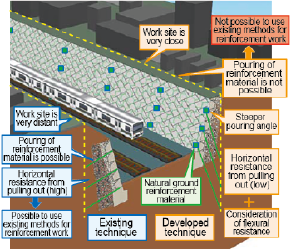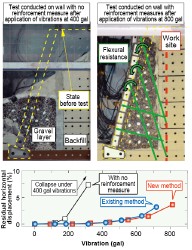3.Seismic reinforcement technology for earth retaining walls in narrow locations
There are over 200 000 earth retaining walls across Japan that were built according to the standard design used by the former national railways. The preponderant seismic reinforcement measure to prevent collapse during large earthquakes, involves pouring natural ground reinforcement material on near-horizontal planes to increase the safety of the earth retaining walls. However, in cities in particular, the crown of the retaining wall is often close to buildings. Given the lack of space, it is difficult to pour reinforcement material along the full length required, which means that even in places which desperately need seismic reinforcement, it is impossible to apply existing remedies.
As such a new technique was developed (Fig.1) using smaller sized equipment suited to narrower locations and capable of pouring reinforcement material at steeper angles and along the full required length. Results from tests on a 1/10 scale model showed that a wall without this seismic reinforcement collapsed under vibrations at 400 gal, whereas as the wall which had been reinforced using this technique resisted to 800 gal vibrations, with horizontal displacement stopping at 4%. These results demonstrate that the new technique offers greater seismic resistance than existing methods, and confirm that seismic resistance is doubled when the method is applied. In addition to proposing a design method taking into account the flexural resistance of reinforcement material poured on steep gradients, a design manual was produced containing all the methods for selecting which kind of seismic reinforcement measure to apply to earth retaining walls.
Other Contents
- 1. Advanced seismograph for earthquake early warnings
- 2.Method for extracting vulnerable structures during earthquakes
- 3.Seismic reinforcement technology for earth retaining walls in narrow locations
- 4. Method for assessing tsunami damage to concrete bridges
- 5. Management of snowmelt for landslide prevention
- 6. Calculation of the aerodynamic coefficient on trains in half-bank half-cut line sections
- 7. Revision of evaluation criteria to check deterioration in lubricating grease used on trains
- 8.Method for detecting step-shaped wear on contact strips on pantograph heads
- 9.Improving lightening resistance of electrical equipment using new grounding structure
- 10.Proposal of method for diagnosing health of concrete masts for maintenance
- 11.On-board platform detection device to assist train crew in train door operation
- 12.Human factor analysis method using Potential Incidents Reports
- 1. Advanced seismograph for earthquake early warnings
- 2.Method for extracting vulnerable structures during earthquakes
- 3.Seismic reinforcement technology for earth retaining walls in narrow locations
- 4. Method for assessing tsunami damage to concrete bridges
- 5. Management of snowmelt for landslide prevention
- 6. Calculation of the aerodynamic coefficient on trains in half-bank half-cut line sections
- 7. Revision of evaluation criteria to check deterioration in lubricating grease used on trains
- 8.Method for detecting step-shaped wear on contact strips on pantograph heads
- 9.Improving lightening resistance of electrical equipment using new grounding structure
- 10.Proposal of method for diagnosing health of concrete masts for maintenance
- 11.On-board platform detection device to assist train crew in train door operation
- 12.Human factor analysis method using Potential Incidents Reports


